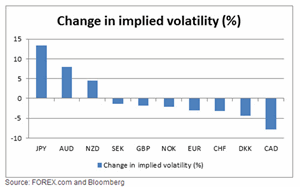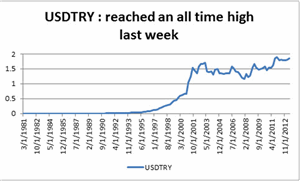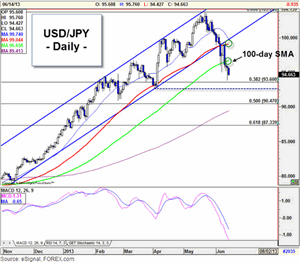Kathleen Brooks and Eric Villoria of Forex.com highlight the events and indicators likely to shape the forex markets this week.
FX Returns Analysis
Moves in the developed FX markets were wild last week and we saw a big spike in volatility.
As you can see above, it was a rough week for the dollar falling against all of the major currencies. The biggest moves were against the JPY, AUD, and NZD. As the dollar selloff gathered pace last week these currencies may have benefitted the most because they had come under the most selling pressure in recent months. After such large moves, the dollar is starting to look oversold, so a recovery could be due as we start a new week.
On a monthly basis, the trends that we have become used to in the FX world have started to shift. USD/JPY has weakened considerably along with USD/CHF, as safe haven currencies are the two strongest performers in the G10. The Aussie and Kiwi remain at the weakest end of the FX spectrum; however they have managed to claw back a significant amount of their losses in recent weeks. Overall, the stronger dollar theme of 2013 has run into a serious road block.
The chart below shows changes in USD/JPY and also the commodity crosses: AUD/USD and NZD/USD , some of the most overbought/ oversold pairs since the start of this year. In contrast, volatility in GBP and EUR was fairly subdued. The CAD did not move as much as the other commodity currencies, potentially because it tends to move more closely with the USD. Overall, large jumps in volatility are fairly rare, and we would expect to see volatility decline in the coming week, which could see USD/JPY resume its uptrend and AUD/USD and NZD/USD continue a more moderate decline.
Fundamental Wrap: Europe and the UK
The economic highlight in the Eurozone will be flash PMI surveys for June released on the 20th. The market continues to expect a moderate pick up in these surveys, and the composite survey is expected to rise to 48.1 from 47.7 in May. This is still at a very low level, but it does suggest that the Eurozone economy is moving in the right direction, albeit at a slow pace. Essentially, if this week's data does come in line with expectations then it supports the ECB's current wait-and-see stance in regards to future policy action. Thus, an improvement in the June data could be EUR supportive, especially against the USD and JPY as their respective central banks are still pursuing expansionary monetary policies. Also watch out for the Bundesbank's monthly report released on Monday and a speech by ECB head Mario Draghi in Jerusalem on Tuesday.
NEXT PAGE: Central Banks Change Tack on Emerging Markets
|pagebreak|In the UK, Tuesday's inflation data for May will be the focus. The market expects prices to tick up to a 2.6% annual rate from 2.4% in April, which, although it is still below the 3.1% average rate of the last 12 months, adds to the reasons why Mark Carney, the new Governor of the Bank of England, should not rush into increasing the BOE's QE program. Retail sales are also released on Thursday, which should show a strong recovery in consumer spending last month after a dismal April reading. Public sector finances on Friday are expected to compare favorably to last year's data. BOE minutes released on Wednesday are unlikely to be a market-moving event; likewise, we don't think that the G8 meeting this weekend in Northern Ireland will deliver any important news from the market's perspective.
Central Banks Change Tack on Emerging MarketsCurrencies across emerging markets saw a huge spike in volatility last week as risk aversion surged, sending emerging markets falling sharply. The selloff in EM FX and in EM equities has been gathering pace for the last month or so as the markets have started to focus on the potential for the Federal Reserve in the US to taper QE3. The selloff reached a peak last week with the Indian rupee and Turkish lira reaching record lows versus the USD. At this point central banks from as far afield as Brazil, Poland, Indonesia, and India intervened to halt the decline in their currencies. This intervention included physical purchases in the FX market in Brazil and Turkey, as well as preventative rate increases in Indonesia and India along with capital controls.
Not that long ago Brazil's finance minister was worried about the economic impact of having a currency that was too strong, so why the change? Emerging market central banks don't like it when their currencies drop too fast as it can have a big impact on inflation. Rising inflation in Brazil, Poland, and India etc. can hurt economic growth and cause social unrest. For example, there were riots in the streets of Sao Paulo this week after the government raised the price of transportation fares, which aggravated the selloff in the real.
NEXT PAGE: All Eyes on FOMC
|pagebreak|There is a troika of downward pressure on EM FX at the moment. Firstly, if the Fed does indeed start to slow its asset purchases then we could see liquidity start to drain from markets that have been beneficiaries of QE funds including EM bond and FX markets. This could cause a disorderly rise in yields in EM that could hurt economic growth and burst asset bubbles where credit growth has been rapid, such as China. The second issue is that some EM countries are reliant on commodities, such as Russia, Brazil, and South Africa. We believe that the commodity cycle has peaked and prices may continue to decline, which could hurt the rand, the ruble, and the real further. Thirdly, unrest in Turkey triggered memories of the Arab Spring, which also spooked investors and reminded them of the risk involved in investing in emerging markets.
Going forward, if the Fed can contain the fallout from the talk about tapering QE3 at its meeting this week then we could see EM FX continue its recovery. However, we think that currencies like the real, lira, rand, and rupee are vulnerable if risk aversion continues to spike. While officials were able to intervene this time, FX reserves are not finite and central banks could soon run out of tools, giving the market even more reasons to sell. For example, the Brazilian authorities have less than $360bn of FX reserves and last week alone they used $5bn of them trying to prop up their currency.
All Eyes on FOMCMarkets have been particularly sensitive to QE expectations and interest rates as the prospect of tapering asset purchases has been a topic of debate. Speculation that the Fed may reduce the pace of asset purchases drove US treasury yields higher and has weighed on equity markets. The dollar has had a mixed response. In general, a reduction in asset purchases tends to be positive for the dollar while prolonged asset purchases are likely to be USD negative. The buck also responds to many other factors, including economic data, geopolitical factors, fiscal policy, and capital flows to name a few.
Economic data supports the view for ongoing QE from the Fed as labor market improvement continues to be sluggish and inflation has slowed. Therefore, we think that the Fed is likely to maintain current policy at its meeting next week and may try to use it communications to clarify the outlook for QE. We agree that the next likely move will be a tapering of asset purchases rather than an increase, however it is important to note that tapering is not tightening. Tapering means that the Fed will continue to expand its balance sheet, but at a slower pace. Tightening will not occur until the balance sheet shrinks.
NEXT PAGE: Will JPY Strength Persist?
|pagebreak|The FOMC will hold a two-day policy meeting next week on June 18-19. The statement will be released along with an updated summary of economic projections at 1400ET and Chairman Bernanke will hold a press conference 30 minutes after the release. As we have written several times in the past, more clarity is needed from the Fed, and we think that the Bank will use next week's meeting as an opportunity to attempt to provide clarification. The likely impact on the USD may be negative at first if the Fed suggests no imminent tapering of purchases, however the buck may gain in the medium- to longer-term as tapering indicates a self-sustaining improvement in economic conditions.
Will JPY Strength Persist?The JPY has strengthened significantly against its major counterparts after the Bank of Japan made no change to policy at its meeting earlier this week. In the G10 space, the JPY is currently the strongest performing currency against the buck, gaining nearly 3%. USD/JPY has seen a steep decline after being rejected from the base of the previously broken upwards trend channel and is currently trading below the 95.00 figure.
Technical and fundamental factors have put upward pressure on the yen of late, however we do not think that Japanese officials will give up on their efforts to reflate the economy and expect the JPY to resume its downtrend as a result.
In the near-term, there is room for continued downside in USD/JPY while it remains below the 100-day simple moving average (SMA) and below the daily Ichimoku cloud. The pair broke below the base of the daily Ichimoku cloud this past week for the first time since October 2012. The base of the cloud is currently around the 97.00 figure and rises towards the 98.00 figure by the end of next week. Above that, the pivotal 55-day SMA is currently around the 99.00 figure. Key levels to the downside are the 38.2% Fibonacci retracement (of the rally from 2012 lows to 2013 highs) just above 93.50 and then the April lows around 92.50.
By Kathleen Brooks and Eric Villoria of Forex.com

























